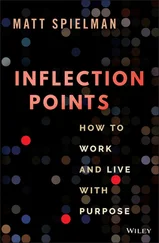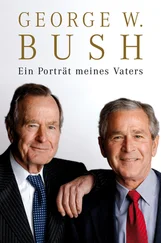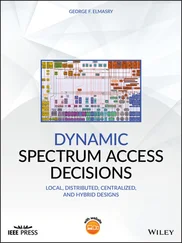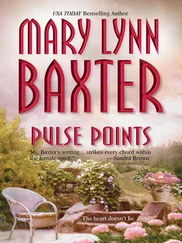My blood was boiling. We were going to find out who did this, and kick their ass.
The shift to wartime was visible at the airport. Agents carrying assault rifles surrounded Air Force One. Two of the flight attendants stood at the top of the stairs. Their faces betrayed their fear and sadness. I knew millions of Americans would be feeling the same way. I hugged the flight attendants and told them it would be okay.
I stepped into the presidential cabin and asked to be alone. I thought about the fear that must have seized the passengers on those planes and the grief that would grip the families of the dead. So many people had lost their loved ones with no warning. I prayed that God would comfort the suffering and guide the country through this trial. I thought of the lyrics from one of my favorite hymns, “God of Grace and God of Glory”: “Grant us wisdom, grant us courage, for the facing of this hour.”
While my emotions might have been similar to those of most Americans, my duties were not. There would be time later to mourn. There would be an opportunity to seek justice. But first I had to manage the crisis. We had suffered the most devastating surprise attack since Pearl Harbor. An enemy had struck our capital for the first time since the War of 1812. In a single morning, the purpose of my presidency had grown clear: to protect our people and defend our freedom that had come under attack.
The first step of any successful crisis response is to project calm. That was what I had tried to do in Florida. Next, we needed to sort out the facts, take action to secure the nation, and help the affected areas recover. Over time, we had to devise a strategy to bring the terrorists to justice so they would not strike again.
I called Dick Cheney as Air Force One climbed rapidly to forty-five thousand feet, well above our typical cruising altitude. He had been taken to the underground Presidential Emergency Operations Center—the PEOC—when the Secret Service thought a plane might be coming at the White House. I told him that I would make decisions from the air and count on him to implement them on the ground.
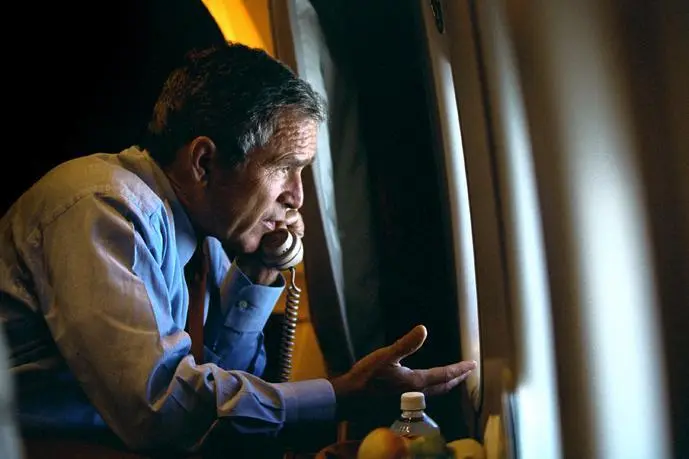
On the phone with Dick Cheney aboard Air Force One on 9/11. White House/Eric Draper
Two big decisions came quickly. The military had dispatched Combat Air Patrols—teams of fighter aircraft assigned to intercept unresponsive airplanes—over Washington and New York. Air-to-air intercepting was what I had trained to do as an F-102 pilot in the Texas Air National Guard thirty years earlier. In that era, we assumed the targeted aircraft would be a Soviet bomber. Now it would be a commercial airliner full of innocent people.
We needed to clarify the rules of engagement. I told Dick that our pilots should contact suspicious planes and try to get them to land peacefully. If that failed, they had my authority to shoot them down. Hijacked planes were weapons of war. Despite the agonizing costs, taking one out could save countless lives on the ground. I had just made my first decision as a wartime commander in chief.
Dick called back a few minutes later. Condi, Josh Bolten, and senior members of the national security team had joined him in the PEOC. They had been informed that an unresponsive plane was headed toward Washington. Dick asked me to confirm the shootdown order I had given. I did. I later learned that Josh Bolten had pushed for clarification to ensure that the chain of command was respected. I thought back to my days as a pilot. “I cannot imagine what it would be like to receive this order,” I told Andy Card. I sure hoped no one would have to execute it.
The second decision was where to land Air Force One. I felt strongly that we should return to Washington. I wanted to be in the White House to lead the response. It would reassure the nation to see the president in the capital that had been attacked.
Shortly after we took off from Sarasota, Andy and Eddie Marinzel, the wiry athletic Secret Service agent from Pittsburgh who led my detail on 9/11, started to throw cold water on the idea. They said conditions in Washington were too volatile, the danger of attack too high. The FAA believed six planes had been hijacked, meaning three more could be in the air. I told them I was not going to let terrorists scare me away. “I’m the president,” I said firmly. “And we’re going to Washington.”
They stood their ground. I hated the image of terrorists putting me on the run. But as much as I wanted to get back, I recognized that part of my responsibility was to ensure the continuity of government. It would be an enormous propaganda victory for the enemy if they took out the president. The military aide and Secret Service agents recommended that we divert the plane to Barksdale Air Force Base in Louisiana, where we could refuel. I relented. A few minutes later, I felt Air Force One bank hard to the west.

One of my greatest frustrations on September 11 was the woeful communications technology on Air Force One. The plane had no satellite television. We were dependent on whatever local feeds we could pick up. After a few minutes on a given station, the screen would dissolve into static.
I caught enough fleeting glimpses of the coverage to understand the horror of what the American people were watching. Stranded people were jumping to their deaths from the top floors of the World Trade Center towers. Others hung out of windows, hoping to be rescued. I felt their agony and despair. I had the most powerful job in the world, yet I felt powerless to help them.
At one point, the television signal held steady long enough for me to see the south tower of the World Trade Center collapse. The north tower fell less than thirty minutes later. I had held out hope that the desperate souls trapped on the upper floors would have time to escape. Now there was no chance.
The collapse of the towers magnified the catastrophe. Fifty thousand people worked in the buildings on a typical business day. Some had been evacuated, but I wondered how many were left. Thousands? Tens of thousands? I had no idea. But I was certain that I had just watched more Americans die than any president in history.
I kept up-to-date on the latest developments by calling Dick and Condi in the PEOC. We tried to establish an open line, but it kept dropping. In the years ahead, Deputy Chief of Staff Joe Hagin oversaw major upgrades to the communications systems of the PEOC, Situation Room, and Air Force One.
When we did receive information, it was often contradictory and sometimes downright wrong. I was experiencing the fog of war. There were reports of a bomb at the State Department, a fire on the National Mall, a hijacked Korean airliner bound for the United States, and a call-in threat to Air Force One. The caller had used the plane’s code name, Angel, which few people knew. The most bizarre report came when I was informed of a high-speed object flying toward our ranch in Crawford. All of this information later proved to be false. But given the circumstances, we took every report seriously.
One report I received proved true. A fourth plane had gone down somewhere in Pennsylvania. “Did we shoot it down, or did it crash?” I asked Dick Cheney. Nobody knew. I felt sick to my stomach. Had I ordered the death of those innocent Americans?
When the fog lifted, I learned about the heroism aboard Flight 93. After hearing about the earlier attacks in phone calls to loved ones on the ground, the passengers had decided to storm the cockpit. In some of the last words recorded from the doomed flight, a man named Todd Beamer can be heard rallying the passengers into action by saying, “Let’s roll.” The 9/11 Commission later concluded that the revolt of the passengers aboard Flight 93 may have spared either the Capitol or the White House from destruction. Their act of courage ranks among the greatest in American history.
Читать дальше








